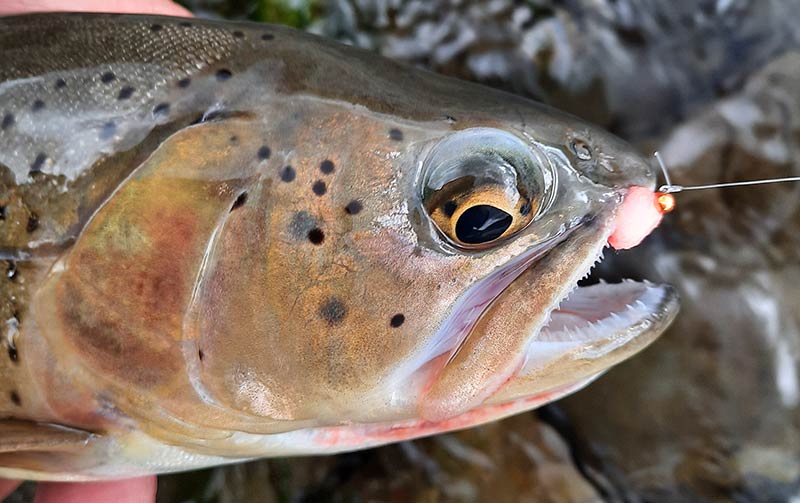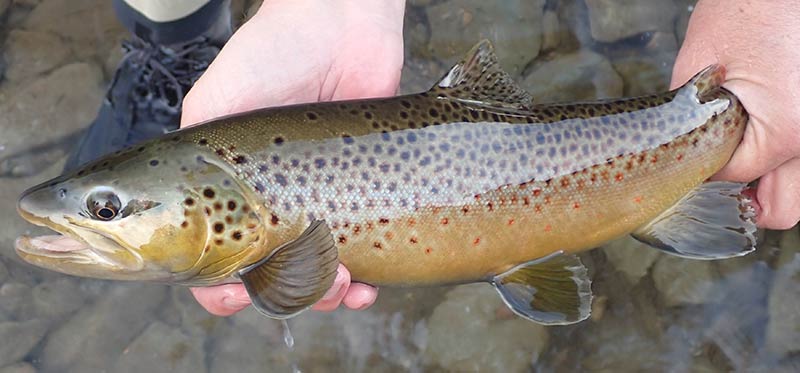Late Fall Yellowstone Fishing Trips
Posted on February 1st, 2021 in Uncategorized
Introduction to October Fishing Trips in Yellowstone
Late fall begins when the first extended cold weather hits, usually around October 1. October fishing in Yellowstone is not for the faint of heart, but it is fantastic for the right anglers in the right places.
While fewer waters fish well at this time than earlier in the year, simply because most waters are already at winter-low flows and have cold water temperatures and lethargic fish to match, those that do fish well at this time fish really well.
The best waters are those that host fall-run brown trout, though nowadays we often focus on the non-spawning trout that follow the brown to eat their eggs and the bugs their spawning behavior disturbs, rather than the browns themselves, both to avoid stressing actively-spawning trout and to avoid the crowds the spawn can bring to the best areas.
That said, the largest numbers of “big brownies” are present in late fall, and unlike in late summer and early autumn it’s seldom necessary to get on the water early if you want to chase these fish.
On the other hand, the weather can be horrendous, with heavy snow and temperatures in the teens more than feasible by this late in the year. As noted above, many waters are simply too cold to fish well by October. An additional unwelcome development in recent years is massively-increased guiding and fishing pressure targeting fall browns, which is one reason we now spend more time chasing the non-migrants on brown trout rivers, since these fish fall between the cracks a bit.

Full confession: I caught this one. Despite the good fishing for large fish, business falls off in late fall. Fewer people want to visit Montana when it might be 20 degrees and snowing, I guess. I’m not alone among Montana outfitters in that I do a high percentage of my own fishing in late autumn.
Important Note on Fishing Ethically During the Brown Trout Spawn
The brown trout spawn begins around October 15. We target browns more aggressively beforehand, since we can be certain we aren’t pursuing active spawners or damaging spawning areas.
After October 15, shallow areas with fist-sized rocks and gravel and steady currents fill with brown trout that are actually settling down to make the next generation. It is unethical to fish in these spawning areas and extremely destructive towards the next generation to do so. We never fish for actively spawning brown trout on our Yellowstone guided trips.
Any guide who does so is unethical and unprofessional and does not deserve your money. If you decide to fish spawning areas on your own, expect thorough tongue-lashings from anglers who fish ethically who happen to see you doing it.
If you didn’t know better about fishing for wild actively-spawning brown trout before reading this, now you do.
There’s no reason to worry: the deep pools and turbulent boulder-bottomed water where the big browns rest on their journeys to their spawning areas hold plenty of fish right up until the park closes. These include both pre-spawn fish on their migrations and post-spawn fish that are done “doing the deed.” Rest assured you can still catch big fish without fear of stressing the active spawners.
Late Fall Yellowstone Fishing Trips: Quick Facts
- Best Waters: Rivers that receive fall-run brown trout from larger lakes and rivers are our favorite fisheries on October fishing trips in Yellowstone, but the Yellowstone River and portions of the Firehole and Gibbon remain good choices for visitors who would rather fish dry flies.
- Three Top Reasons to Fish Yellowstone in Late Fall: 1.) You are eager to target larger brown trout using nymphs and streamers. Most fall browns run 14 to 20 inches, but a few giants are caught every October. 2.) You like fishing in awful weather. 3.) Most water in Yellowstone Park is devoid of other anglers.
- Three Top Reasons to Avoid Late Fall: 1.) Few rivers still fish consistently well in October and early November, especially if you’re looking for numbers of trout rather than big ones. 2.) Some of the best brown trout water is still extremely crowded except during below-freezing and inclement weather. 3.) Dry fly fishing is inconsistent, even on waters where we don’t get “big fish on the brain.”
- Perfect Clients: Late fall is best for experienced anglers who come prepared to fish in uncomfortable weather in exchange for the potential for lots of trout and some big ones fishing subsurface flies.
- What Late Fall Does Best: Contrary to the above, the absolute best fishing in late autumn in Yellowstone is actually found by targeting the non-spawning rainbow and cutthroat trout that follow the brown trout to eat their eggs and the insects they disturb, then fishing the browns when the pools where they congregate are uncrowded. With ever-increasing pressure on the brown trout and fewer and fewer good brown trout spots that go underfished (thanks Instagram and Facebook), fishing for the non-migrant fish is a way of getting lots of fish in uncrowded conditions, with some big fish too.
October Trips: The Details
The transition from early autumn to late is based on light levels, water temperatures, and weather. Basically, once there have been several days in a row with daytime highs under 50 degrees and nights in the high teens or even lower, and some snow has stuck around for a day or two even at valley level, it’s late autumn. Usually this means the month of October and early November.
The weather now is often dreadful. The best fishing takes place when it is dreadful, which means good waders, a good waterproof jacket, several layers underneath both waders and jacket, and a warm hat and gloves are required. That said, the fishing can still be solid on the occasional Indian summer sort of day, as the picture below shows. Crowding is more likely when it’s warm and bright, of course.

Most fisheries in Yellowstone Park are no longer worth fishing. Small creek, including famous names like Soda Butte Creek, often show ice in the backwaters and hold fish that have gone into their winter stupors. These fish may feed an hour each afternoon, but they may not really feed at all. Larger rivers like the Lamar and the Yellowstone in its Grand Canyon may still be worth it on warm afternoons, particularly early in October, but they’re not the stars of the show, either.
Instead, virtually all the good October fishing in Yellowstone occurs medium-sized and larger rivers that possess one or preferably both of the following features:
- They host runs of spawning brown trout, either from lower down in the same drainage or from a lake or river downstream.
- And/or they receive substantial geyser basin discharge that keeps water temperatures high and both trout and insects more active than on cold rivers.
For our guide service, the browns are the main show. While we fish portions of the Black and Grand Canyons of the Yellowstone some in early October, and once in a blue moon run a guided trip for small resident trout on the Firehole, the vast majority of our guiding and fishing in late fall relates in some ways to the brown trout.
Sometimes we target the big pre-spawn browns migrating towards their spawning grounds like salmon, sometimes we target the resident rainbow and cutthroat trout or even the big run-up rainbows that follow the browns, eating eggs. Either way, the brown trout are the drivers.
Don’t get me wrong. We’ll fish dry flies when the fish are going wild for them, but unlike summer when dry fly fishing is our preferred tactic, in late fall it’s the side dish rather than the main course.

Rainbow, cutthroat, and cutt-bow trout like this one gorge on brown trout eggs and often see little pressure from anglers in October.
Late fall fishing is primarily nymph-fishing, with large stonefly nymphs trailing either some sort of small attractor nymph or an egg fly. While conventional wisdom might state that the non-spawning trout would tend to eat the eggs and small flies and the big angry spawners would be more likely to eat the stonefly nymphs, sometimes the reverse is true and the big fish eat the small bugs. We mark this down to pressure.
Keep that in the back of your mind: the heavier the pressure, the more likely the conventional “big nasty” stuff doesn’t work as well as small stuff. Streamers can also work, especially when the weather is ugly and pressure is low.
All of the above fishing is great fun for experienced anglers, but usually pretty tough for beginners. While our Yellowstone fishing guides are certainly willing to guide beginners in late fall, this is not the easiest time for them. It’s a particularly poor choice for young kids, since the cold weather and danger of falling into cold weather makes things miserable and perhaps hazardous for people who haven’t hit their growth spurts yet.

Brown trout get dark and colorful as the spawn approaches. This one was caught in early October about 10 days before the spawn begins.
Most October fishing trips in Yellowstone are half-day trips. Since even the light-sensitive browns are now eager to eat throughout the day and angling crowds are almost nonexistent in the right places, there’s no need to get out at the crack of dawn when in might be ten or fifteen degrees. We’ll instead usually fish from just after lunch until sunset, prime time in the first case for BWO activity and in the latter for the largest browns.
Montana float & wade trips and Private spring creeks also turn on strong at this time, with the same runs of browns that drive the Yellowstone Park fishing. They’re also the only opportunity for the above fishing after Yellowstone Park closes to angling at sunset on the first Sunday in November.